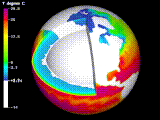
 Sea temperatures from 20 layer ocean model for April.
Sea temperatures from 20 layer ocean model for April.
The ocean component of the GENESIS coupled model is the global model described by Washington et al. (1994), derived from the high resolution model of Semtner and Chervin (1988). It is highly vectorized and parallelized for running on NCAR's Cray supercomputers.
The OGCM predicts the evolution of ocean horizontal and vertical velocity, temperature, and salinity fields globally over the full depth of the ocean. Two horizontal grid resolutions are used: 2 degrees longitude by 2 degrees latitude and 1 degree longitude by 1 degree latitude. There are 20 vertical levels between the surface and the maximum bottom depth of 5200m and realistic coastlines and bottom topography at the horizontal grid resolutions. The vertical resolution is 25m in the upper 100m. The vertical resolution decreases with depth such that there are 11 levels in the upper 1000m and 15 in the upper 2750m. The spin up of the deep levels is accelerated by a factor of 10 over the surface levels using the `distorted physics' technique developed by Bryan (1984).
The stand-alone version is spun up from rest with forcing in the upper level only. The momentum input for the stand alone version is Hellerman and Rosenstein (1983) monthly mean wind stress climatology. The surface heat and freshwater input are parameterized by restoring to seasonally varying temperature and salinity climatologies. Both Levitus (1982) and Shea, Trenberth and Reynolds (1990) climatologies are used for temperature. The coupled OGCM receives surface forcing fields from the AGCM. Fluxes, of heat, freshwater and momentum (wind stress) will be calculated from surface air and sea temperatures, humidity, wind velocity and preciptation and passed into the ocean model.
12/8/97